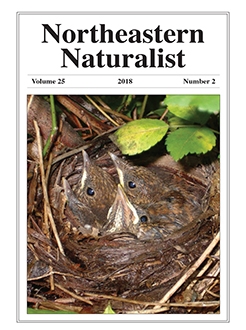The arrival of white-nose syndrome (WNS) to North America in 2006, and the subsequent decline in populations of cave-hibernating bats have potential long-term implications for communities of forest-dwelling bats in affected regions. Severe declines in wintering populations of bats should lead to concomitant shifts in the composition and relative abundance of species during the staging, maternity, and swarming seasons in nearby forested habitats. We examined capture rates of bats collected in mist nets from 2009 to 2016 to evaluate summer patterns in abundance of species pre- and post-arrival of WNS to Mammoth Cave National Park, KY. The data demonstrated a significant change in overall relative abundances. Myotis septentrionalis (Northern Long-eared Myotis) was the most commonly captured species pre-WNS but declined to 18.5% of its original abundance. Nycticeius humeralis (Evening Bat), uncommonly caught in mist nets pre-WNS, demonstrated the largest increase in capture success following arrival of WNS to the Park, followed by Eptesicus fuscus (Big Brown Bat) and Lasiurus borealis (Eastern Red Bat). These data suggest that losses of cave-hibernating bats to WNS may be leading to a restructuring of foraging bat assemblages in nearby forested habitats, with species less affected by WNS potentially exploiting niche space vacated by bats succumbing to infection with WNS.
How to translate text using browser tools
1 May 2018
Shifts in Assemblage of Foraging Bats at Mammoth Cave National Park following Arrival of White-nose Syndrome
Marissa M. Thalken,
Michael J. Lacki,
Joseph S. Johnson
ACCESS THE FULL ARTICLE

Northeastern Naturalist
Vol. 25 • No. 2
May 2018
Vol. 25 • No. 2
May 2018




